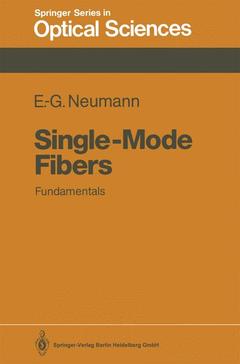Description
Single-Mode Fibers, Softcover reprint of the original 1st ed. 1988
Fundamentals
Coll. Springer Series in Optical Sciences, Vol. 57
Author: Neumann Ernst-Georg
Language: French
Publication date: 10-2013
533 p. · 15.5x23.5 cm · Paperback
533 p. · 15.5x23.5 cm · Paperback
Description
/li>Contents
/li>
Single-mode fibers are the most advanced means of transmitting information, since they provide extremely low attenuation and very high bandwidths. At present, long distance communication by single-mode fibers is cheaper than by conventional copper cables, and in the future single-mode fibers will also be used in the subscriber loop. Since single-mode fibers have many applications, a variety of people need to understand this modern transmission medium. How ever, waveguiding in single-mode fibers is much more difficult to understand than waveguiding in copper lines. A single-mode fiber is a dielectric waveguide operated at optical wave lengths. Since 1961, I have been involved in experimental and theoretical re search on dielectric rod waveguides in the microwave region. From the experi ments, I learned much about the properties of a wave guided by a dielectric rod or a glass fiber, especially about its behavior at waveguide discontinuities like bends, gaps, or the waveguide end. Since 1972, my co-workers and I have also been investigating dielectric waveguides at optical frequencies, and since 1973 I have lectured on "Optical Communications". These activities have shown that there is a need for a tutorial introduction to the new technical field of single mode fibers. In this book the physical fundamentals are emphasized and the mathematics is limited to the absolutely necessary subjects. Besides presenting a physical explanation of waveguiding in single-mode fibers, it is also the aim of this book to give an overview of the knowledge accumulated in this field.
Physical Explanation of Waveguiding by Single-Mode Fibers.- Electromagnetic Fields.- Gaussian Beams.- The Fundamental Fiber Mode.- Higher-Order Modes.- Launching of Modes.- Radiation from the Fiber End.- Joints Between Fibers.- Spot Size and Width of the Radiation Pattern.- Signal Transmission Through Single-Mode Fibers.- Components for Single-Mode Fibers.- Measuring Techniques.
© 2024 LAVOISIER S.A.S.




